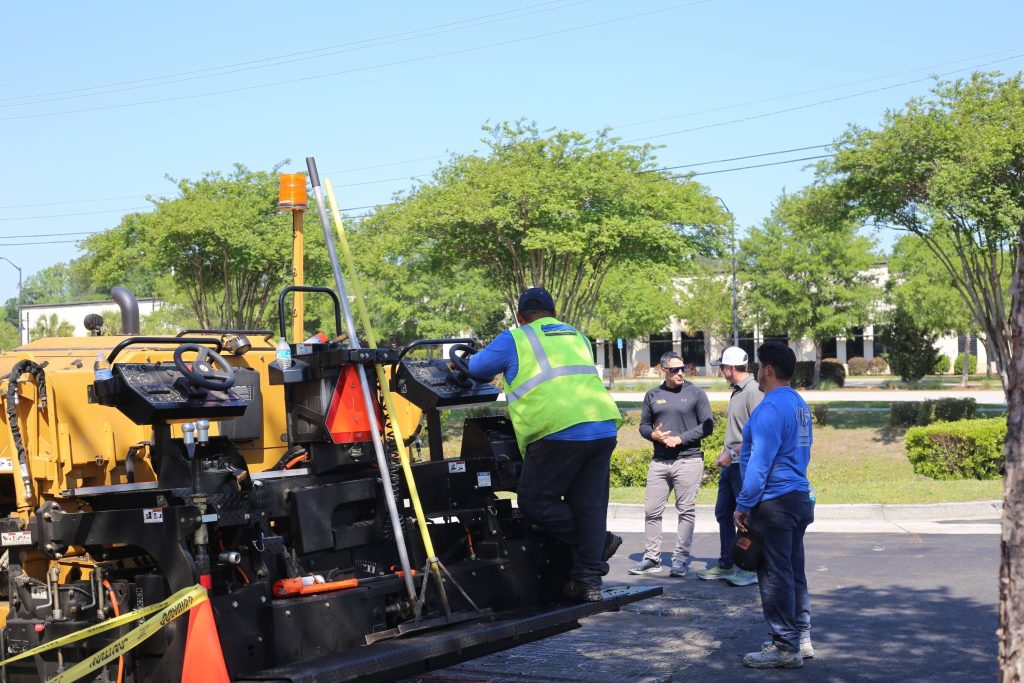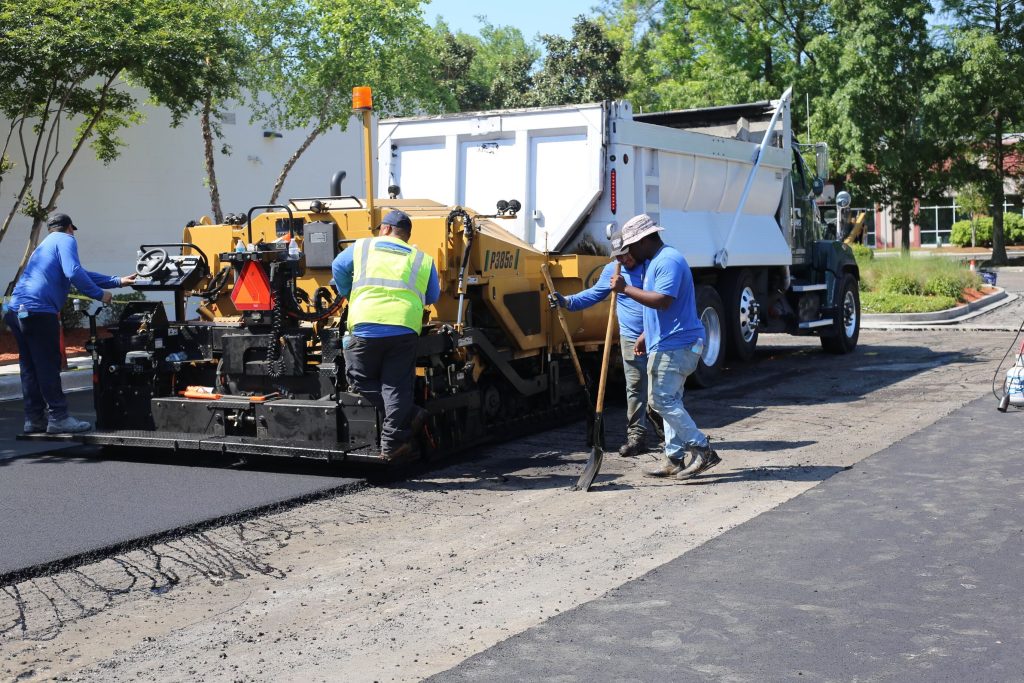When people pull into a commercial property the very first impression often happens before they even step through the door. A parking lot is not just a place to leave vehicles. It is a moving system that influences safety, convenience, and even customer satisfaction. Have you ever noticed how a poorly designed lot creates frustration before a shopper or tenant even arrives at the front entrance. That moment matters more than many businesses realize. Optimizing traffic flow with asphalt paving isn’t just about smoother roads. It’s about creating order out of chaos, guiding drivers naturally, and showing that a business values the people who use its space.
Why Traffic Flow Matters More Than You Think
Asphalt paving for a commercial parking lot might look simple on the surface, but the way vehicles move through it affects everything from liability to brand reputation. Confusing layouts cause bottlenecks. Poor pavement conditions slow traffic and increase accidents. Unclear striping makes drivers second-guess their decisions. On the other hand, an asphalt surface designed with the right layout and markings becomes a silent guide. It directs cars and pedestrians safely and efficiently without anyone thinking twice about it. That’s the power of flow.
The Role of Asphalt Paving in Parking Lot Design
Is your parking lot a source of frustration for customers and employees? Asphalt paving is a key element in effective parking lot design, addressing issues like traffic congestion, safety concerns, and visual appeal.
Asphalt as the Foundation
Asphalt paving provides the structural strength and smooth surface needed for heavy traffic. Unlike other materials, asphalt absorbs movement, flexes under pressure, and reduces cracking when properly maintained. This flexibility makes it ideal for lots that experience high volumes of vehicles daily.
Safety and Visibility
Fresh asphalt combined with professional striping enhances visibility for drivers and pedestrians. Clear markings show exactly where to stop, yield, or park. Well-planned traffic arrows and lane dividers keep cars moving steadily. This reduces hesitation and lowers the risk of collisions.
Cost-Effective Efficiency
Businesses often weigh cost when choosing paving solutions. Asphalt is not only more affordable upfront but also easier to repair and maintain over time. A well-maintained asphalt lot can last decades, meaning it supports smooth traffic flow long into the future.
Strategies to Optimize Traffic Flow with Asphalt Paving
Efficient traffic flow is essential for any well-functioning parking lot. Asphalt paving offers a range of strategies to optimize vehicle movement, reduce congestion, and improve the overall parking experience.
1. Smart Layout and Striping
Think of striping as the language of the parking lot. Bright, well-placed lines tell drivers exactly where to go. The angle of parking spaces, the width of drive aisles, and the placement of arrows all influence movement. Diagonal spaces often speed up flow in smaller lots while straight spaces can maximize capacity in larger ones.
2. Designated Entry and Exit Points
Nothing clogs up a lot faster than unclear entry and exit routes. Asphalt paving projects should account for clear directional signs and markings. Creating separate lanes for entering and exiting traffic makes the entire system more predictable.
3. Pedestrian Pathways
People on foot are often forgotten in parking lot design. A safe asphalt walkway separated from vehicle lanes not only prevents accidents but also creates a more welcoming environment. Marked crosswalks in bright paint signal to drivers that they must yield.
4. Drainage and Water Flow
Standing water disrupts more than the surface. It damages asphalt, creates potholes, and slows traffic. A well-engineered asphalt lot uses proper grading and drainage to move water away quickly. Smooth flow means fewer hazards and less frustration.
5. Lighting and Visibility Enhancements
Traffic doesn’t stop when the sun goes down. Adequate lighting paired with reflective striping makes movement easy to follow at night. This small detail is often overlooked but makes a huge difference for both safety and efficiency.
Customer Experience
“When we hired The Pavement Group to repave our shopping center’s lot we honestly thought it was just going to be about fixing cracks and filling potholes. What surprised us most was how much smoother traffic became. Before the project customers were always complaining about bottlenecks near the main entrance. After the redesign with new asphalt paving and striping cars flow in and out seamlessly. Our tenants even mentioned that people are staying longer because they don’t get frustrated parking. It felt less like a repair and more like a transformation of the entire property. ”
-Tracy M., Property Manager
Long-Term Benefits of Asphalt Paving for Businesses
Asphalt paving is a strategic investment that can yield significant long-term benefits for businesses. Here’s why:
Increased Customer Satisfaction
A smooth parking lot makes the overall customer experience feel better. People rarely talk about a good lot but they always complain about a bad one. By removing obstacles and frustration you silently win points with every visitor.
Lower Liability Risks
Cracks, potholes, and unclear markings open the door to accidents and claims. Investing in asphalt paving minimizes those risks. Businesses that proactively manage their lots avoid costly legal battles and insurance headaches.
Stronger Brand Perception
A lot is part of the brand story. If someone pulls into a clean, well-marked asphalt surface they immediately associate the business with professionalism and care. That first impression lingers long after they leave.
How The Pavement Group Delivers Results
The Pavement Group takes a holistic approach to asphalt paving for commercial parking lots. It isn’t only about asphalt but about designing a flow that fits the specific needs of each property. From analyzing traffic patterns to creating detailed striping layouts the goal is always to balance safety, efficiency, and aesthetics. Their team understands that a lot is more than a surface. It is a system that affects every single person who visits.
Optimize Your Parking Lot with Asphalt Paving
If your commercial parking lot is slowing people down it’s time to take action. Don’t wait for potholes, complaints, or accidents to dictate the next move. Let The Pavement Group show you how asphalt paving can completely transform the way traffic flows through your property. Contact us today for a consultation and discover how the right design and paving solution can turn your lot into a safe, efficient, and welcoming space.
Frequently Asked Questions
1. How does asphalt paving improve traffic flow in commercial parking lots?
Asphalt paving creates a smoother surface that allows vehicles to move more easily without slowing down for cracks or potholes. Fresh paving also provides a clear base for striping, which guides cars and pedestrians. Together, these upgrades reduce congestion and improve overall safety.
2. What is the best layout design for parking lot traffic flow?
The best layout depends on the size and type of property, but angled spaces often help smaller lots while straight spaces maximize larger ones. Wide drive aisles and clearly marked entry and exit points prevent bottlenecks. A thoughtful design directs vehicles naturally and avoids confusion.
3. Why is striping important for parking lot efficiency?
Striping serves as the “map” of the parking lot, showing drivers exactly where to park, stop, or yield. Bright, well-planned lines reduce hesitation and keep traffic flowing in the right direction. Without striping, drivers create their own rules, which often leads to chaos.
4. How does drainage affect traffic flow in asphalt parking lots?
Poor drainage leads to standing water, which damages asphalt and creates hazards for vehicles and pedestrians. Puddles and potholes slow traffic down and increase accident risks. Proper grading and drainage systems keep water moving and maintain smooth, safe flow.
5. What role does lighting play in parking lot traffic flow?
Good lighting ensures that striping, arrows, and signage are visible even at night. Drivers move more confidently when they can clearly see where to go. This not only improves flow but also enhances safety and security for everyone on the property.
6. Can asphalt paving reduce accidents in commercial parking lots?
Yes, a well-paved and clearly marked asphalt lot guides traffic in a way that reduces driver hesitation and risky maneuvers. Smooth surfaces lower the chance of sudden stops or swerves caused by potholes. Clear crosswalks also help protect pedestrians.
7. How often should a commercial parking lot be repaved?
Most asphalt lots need repaving every 15–20 years depending on traffic volume and maintenance. Regular sealcoating and crack filling can extend the life of the pavement. Timely upkeep helps preserve flow and safety for both drivers and pedestrians.
8. What are the cost benefits of using asphalt paving for traffic flow?
Asphalt is cost-effective compared to other materials because it’s quicker to install and easier to repair. A smoother flow of vehicles reduces wear and tear on the lot, lowering long-term maintenance costs. Over time, the investment pays off by improving safety and efficiency.
9. How do pedestrian pathways impact parking lot traffic?
Designated asphalt walkways and crosswalks separate pedestrians from moving cars. This reduces sudden stops or accidents that slow down traffic flow. Clear pedestrian routes keep vehicles moving smoothly and people walking safely.
10. What are the long-term advantages of optimizing traffic flow in parking lots?
Efficient flow creates a positive experience for visitors, which boosts customer satisfaction and retention. It also lowers liability risks by reducing accidents and property damage. Over time, a well-optimized lot adds value to the entire property.


